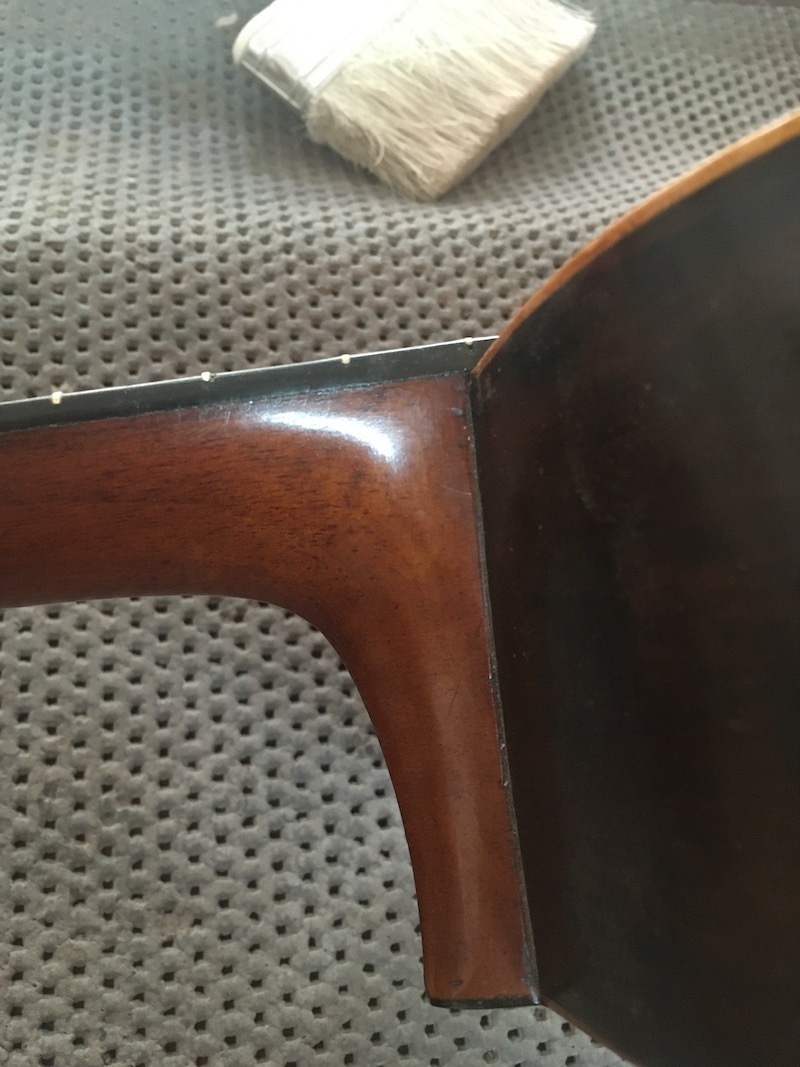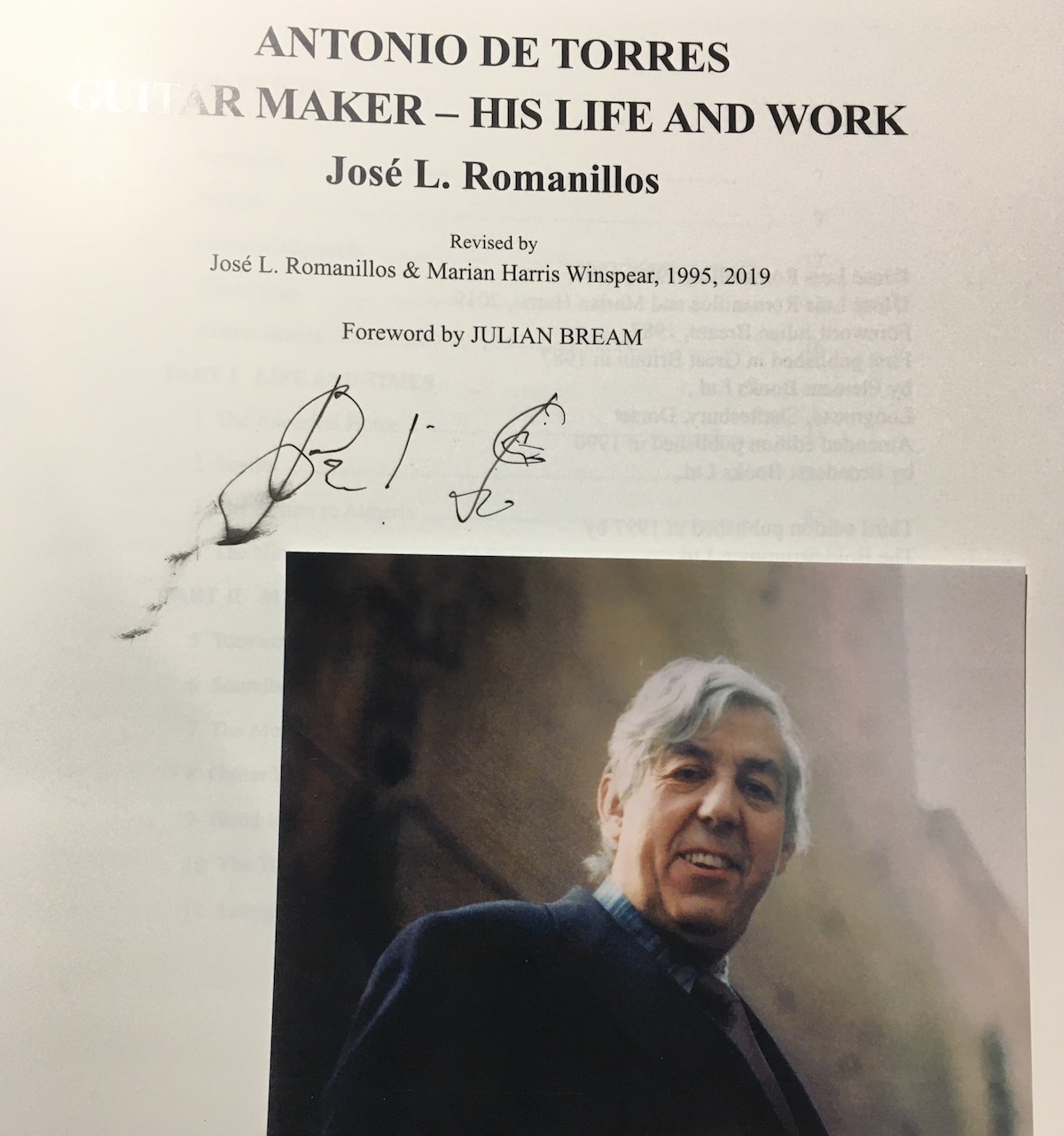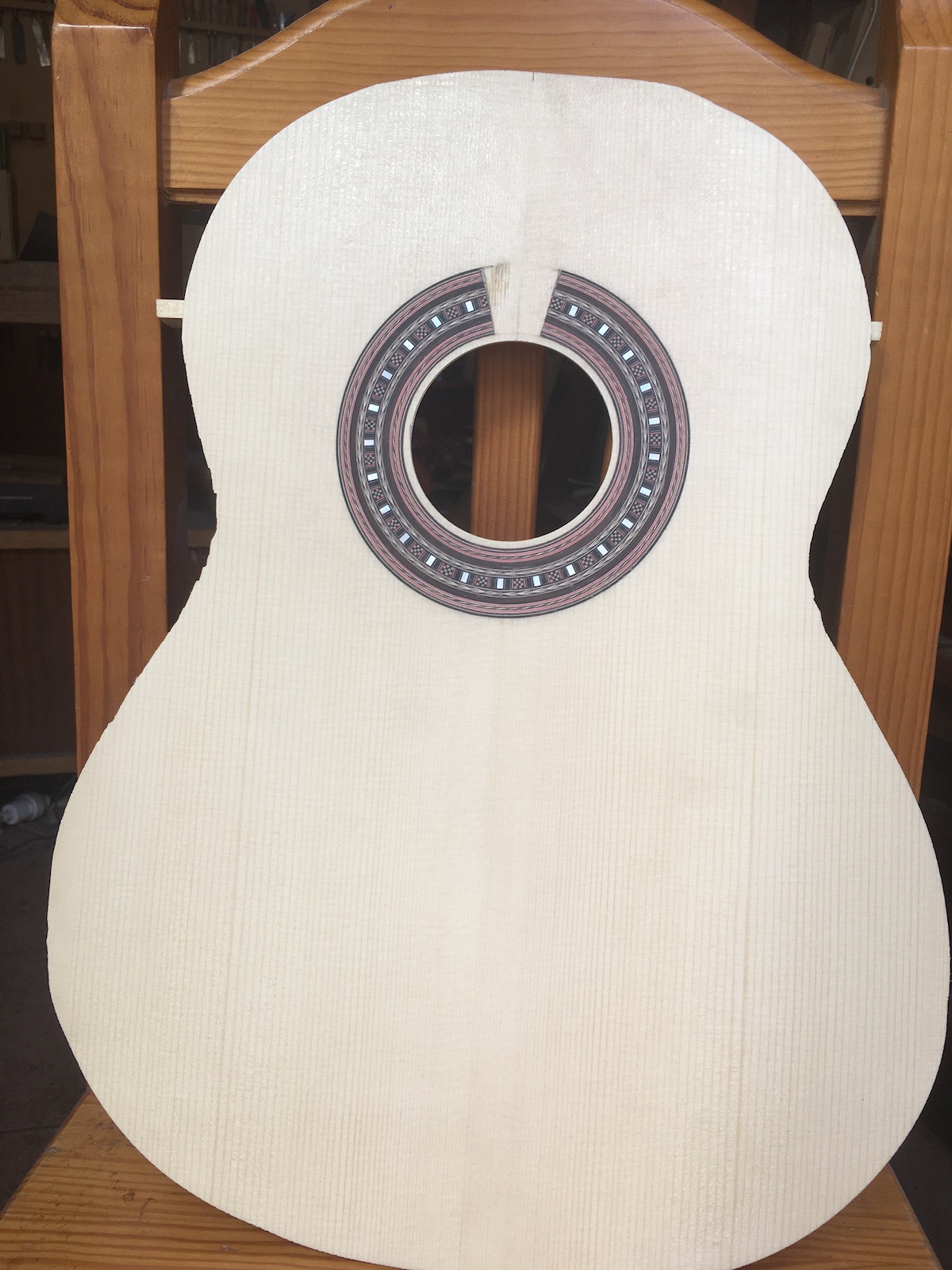Some time ago I mentioned that the National Reference Centre for the Crafts in Granada was organising the first of it’s courses that touch on the subject of musical instruments. “Repair and Maintenance of Stringed Instruments“. Starting date was March 7 of this year and the instructor is Aarón García Ruiz, instrument-maker, doctor in musicology and experienced educator. The course is comprised of 810 hours and each student will receive a professional certificate. We are all hoping that this will be the beginning of a trend towards getting support from the different levels of government for guitar-making in Granada. Many voices have been calling for a guitar museum, an official school and government support for our initiatives in general.
Author Archives: johnray
Josef Pagés 1809
I had another restoration in last month. This was a guitar which had already had some work done on it perhaps on two different occasions. Someone had modified the guitar to conform to what were then modern standards. Neither myself nor the owner thought that undoing all of the changes was a good idea. I fixed a crack or two, installed geared tuning pegs and did some work on the bridge, nut and frets to make it playable.
Josef Pagés was the son of Juan Pagés who was also a guitar-maker. Very influential in the late 18th and early 19th centuries not only in their native Cádiz but all over Spain. Another of the four guitar-making sons, Francisco, who emigrated to Cuba and worked there expanded the fame of the Pagés family.



José Luis Romanillos Vega 1932-2022
Those of us who are driven to write about guitar organology and guitar construction owe so much to José Luis Romanillos. His book on Torres set the bar for that sort of research and turned Torres into a household name among guitar aficionados. I think I have never written an article without referencing that book. Torres’ guitars and research in general have become an important part of my work and whithout his trail-blazing I doubt I would have got here.
I met José Luis and Marian on a number of occasions: here in Granada during their research for the Diccionario and in Córdoba for the Antonio de Torres exhibition. He served on the jury at the guitar-making competition in Gelves in 1999 where I presented a guitar. When I started building copies of Antonio de Lorca he encouraged me and when I uncovered a guitar by Etienne Laprevotte he guided me in my investigations.
I include a quote from the 1987 version of the book which honours the master:
“To say that this book owes a great deal to my wife is an understatement: her encouragement and total support made it possible for me to write this book. Not only did she type the draft several times but also helped give the book its final shape. My indebtedness to her is immeasurable and only her modesty and unselfishness in refusing to share the authorship of this book prevented me from including her name alongside my own. Marian, I thank you.”
Listing of Torres guitars (unconfirmed)
As far as I know the most complete list of Torres guitars is found in the Romanillos book: Antonio de Torres Guitar maker: His Life and Work. I think that is essential that we work to update that list. The only logical way to make an updated list is to start with that seminal work and add to it. So most of the entries here will be those found in the catalogue section of that book. It uses a system which assigns FE and a number to those guitars made before Torres began numbering them and then starting in 1875 uses SE to abbreviate “segunda epoca” and using the number given by Torres on the label of those guitars. The SEU denomination is used in Romanillos to show a guitar from the segunda epoca which is not numbered or has an illegible number. This list will continue the author’s conventions including the use of letters to show that a guitar falls between two consecutive numbers.
The guitars listed here have not neccesarily been examined by the authors but have been documented by written sources or photos. I will add information about each guitar, especially information which will help determine the authenticity of those instruments not found in Romanillos. I am hoping for collaboration from any and all experts and owners of Torres guitars. Each entry on this list will have a link to photos, a description and any information available on authenticity including who authenticated the guitar. I will be asking permission to use that information and will include it as I can. As for the authenticity of the instruments I don’t think anyone can make a judgement without seeing the guitar in question. I am hoping for firsthand information. My email address is email@johnguitar.com.
1852 (Almería)19 currently at Musée de la musique, París
ca. 1853 (Sevilla)19 currently in Torres Museum Almería
1854 FE 01 1
1854 FE 02 1
1856 FE 03 1
1856 FE 04 1
1856 20 small body, narrow rosette and Gutierrez-style head.
1857 FE 05 1
1857 FE 06 1
1857 FE 07 1
1858 FE 08 1
1859 FE 09 1 Llobet
1859 15 two-piece rosewood sides, four-piece back
1859 FE 10 1
1859 FE 10A 1
1860 FE 11 1
1860 2
1860 FE 12 1
1860? 15 five-piece rosewood back, MOP rosette, torn label Sevilla
1860 FE 13 1
1861 15 pink bakelite rosette, tornavoz. 3-piece back
1861 15 3-piece back, brown and white rosette of simple rings.
1862 FE 14 1 pasteboard back and sides
186218 3-piece maple sides, 3 figures on bone bridge plate
1863 FE 15 1
1863 5 pearwood and mahogany back
1863 FE 16 1
1863/64 9 2-piece ribs, rosette green and black, 3-piece cypress back. 1852 label
1864 FE 17 1
1864 3 different headstock, small outline, unusual rosette
1864 FE 18 1
1864 FE 19 1
1864 FE 20 1
1864 FE 21 1
1864 FE 21A 1
1864 FE 21B 1
1864 FE 21C 1
1864 FE 21D 1
186418 4-piece rosewood back, white binding
1865 FE 21X 1
1866 FE 22 1
1866 11
1867 FE 23 1
1867 15 small, Gutierrez-style head, lute bridge
1867 FE 24 1
1867 FE 25 1
1867 FE 26 1
1867 FE 27 1
1867 FE 27A 1
1867 FE 27B 1
1867 FE 27C 1
1867 FE 27D6
1868 FE 28 1
1868 FE 29 1
1868 17 Tornavoz, 3-piece rosewood back, green herringbone
1869 FE 30? 1
1875 SE 2 1
1875 SE 3 2
1876 SE 7 1
1877 SE 9 1
1877 SE 10 1
1877 15 SE bandurria (cypress)
1877 SEU 01 1
???? SEU 02 1
1878 SE 1416***
1882 SE 14 2***
1882 SE 28 1
1882 SE 29 1
1882 SE 30 La Perla
1882 SE 31 1
1882 SE 33 1
1882 SE 34 2
1882 SE 35 13*** (rosewood)
1882 SE 35 12 maple (maybe SE 39)***
1882 SE 37 1
1882 SE 38 2
1882 1 Bandurria (rosewood)
1882 SE 39 2***
1883 SE 43 1
1883 SE 46 3
1883 SE 49 1
1883 SE 54 4
1883 SE 56 22
1883 SE57 10
1884 SE 58 6
18– SE U05 1
1884 SE 59 6
1884 SE 60 1
1884 SE 67 1
1884 SE 69 14
1884 SE 70 1
1884 SE 71 1
1884 SE 72 1
1884 SE 77 1
1885 SE 816
1885 SE 83 1
18– SEU 03 1
1886 SE 87 1
1886 SE 88 1
1886 SE 92 1
18– SE 98 1
1886 SE 99 1
1886 SE 100 1
1886 SE 101 2
18-6 SEU 06 1
1887 SE 103 1
1887 SE 104 1
1887 SE 105 1
1887 SE 107 1
1887 SE 109 2
1887 SE 110 2
1887 SE 111 8
1888 SE 112 1
1888 SE 113 1
1888 SE 114 4
1888 SE 115 1
1888 SE 116 2
1888 SE 117 1
1888 SE 122 7 source states incorrect year
1888 SE 124 9
1889 SE 12611
1889 SE 127 1
1889 SE 129 1
1889 SE 132 21
1889 SE 133 1
1890 SE 138 15
1890 SE 139 1
1890 SE 141 1
1890 SE 142 1
1890 SE 144 3
1890 SE 146 2
1891 SEU 04 1
1892 SE 151 1
1892 SE 151A 1
1892 SE 153 1
1892 SE 155 1
1José Luis Romanillos: Antonio de Torres: Guitar maker: His Life and Work, Madrid: RH Publications, 2021
2James WESTBROOK (2009): Investigative Methods for the Study of Historical Guitars: A Case Study of the Work of Antonio de Torres (M.A. thesis), London Metropolitan University. London
3Julio GIMENO et. al. Antonio de Torres y la guitarra andaluza, Cordoba: Festival de la guitarra de Cordoba, 2007
4Sheldon URLIK: A collection of fine spanish guitars from Torres to the present, Park City: Sunny Knoll Publishing, 2015
5R. E BRUNÉ: “Antonio de Torres 1863”, Vintage Guitar Magazine, May 2008
6Gianni ACCORNERO: Antonio De Torres. Lo Stradivari della chitarra moderna, Cremona: MdV-Museo del Violino, 2018
7Françoise and Daniel SINIER DE RIDDER and Jérôme CASANOVA: La Guitare Espagnole, Paris: Camino Verde, 2019
8Stefano GRONDONA and Luca WALDNER: La chitarra di Liuteria, Sondrio: L’officina del libro, 2001
9Richard Bruné website
10John RAY, Mª José TIRADO and Leopoldo NERI, Roseta No. 16 2022
11Museu de la Música Barcelona
12Vichy Enchères website
13Masahiro Masuda youtube video https://www.youtube.com/watch?v=_ZOc65GwlwY
14Bruce Bannister website “Fine and Rare Guitars”
15unpublished
16Guitar Salon International Youtube channel https://www.youtube.com/watch?v=icSLAMzet2k
17Guitar Salon International Youtube channel https://www.youtube.com/watch?v=kr_6I7Hnz2k
18Guitar Salon International Youtube channel https://www.youtube.com/watch?v=IRmQeB62d3k
19María del Mar POYATOS ANDÚJAR: Antonio de Torres Jurado, Almeria, Universidad Internacional de Andalucía, 2017
202015 auction https://www.bromptons.co/reference/photography/details/guitar-by-antonio-de-torres-spanish-1856.html
21Josep María MANGADO: José Martínez Toboso (1857-1913), El Señor de las Once Cuerdas, 2021
22https://www.youtube.com/watch?v=i0JsJcG5vM4
Prelude at Sunset
Javier Riba kindly allowed me to publish what he wrote here. Translation below.
Preludio al atardecer (1926) de Joaquín Rodrigo Javier Riba (guitarra)
En el año 2019 el musicólogo Javier Suárez-Pajares encontró una pieza inédita de Joaquín Rodrigo en el archivo del compositor titulada “Preludio al atardecer”. Hasta ese momento desconocíamos la existencia de esta composición que, si nos atenemos a la fecha del manuscrito (1926), podría tratarse de la primera obra para guitarra del autor del Concierto de Aranjuez. El “Preludio al atardecer” no es una tentativa de un joven compositor pianista que se acerca a la difícil empresa de escribir para la guitarra; todo lo contrario, es, en mi opinión, una pieza madura, sorprendentemente bien resuelta en el plano instrumental (aunque con una demanda técnica que se adelanta a los parámetros de su época) y muy audaz en el planteamiento tonal. Escrita en el modo flamenco de Do, con armadura de Fa menor (4 bemoles), presenta un episodio central con rasgueados en Mi mayor cuya luminosidad contrasta abruptamente con la oscuridad de las secciones que la preceden y la siguen. El guitarrista Juan Manuel Cañizares ha sido el primero en comunicar la pieza tanto en concierto como en grabación, desde una óptica flamenca, a través de su proyecto “Rodrigo por Cañizares”. Aquí les presento mi lectura “clásica” desde un prisma más académico.
In 2019 musicologist Javier Suárez-Pajares discovered an unpublished score by Joaquín Rodrigo in the composer’s archives titled “Prelude at sunset”. Until that moment we were completely unaware of the existence of this composition which, according to the date (1926), might well be the first piece the author of Concierto de Aranjuez ever wrote for the guitar. But this prelude is hardly a “first try” by a pianistic composer who wishes to take on the difficult task of writing for the guitar; rather it isa mature piece which is surprisingly well resolved on the fretboard of the guitar. It must be said that the technical difficulty is ahead of its time as is the audacious tonal approach. Written in flamenco mode in C with a key signature of F minor (4 flats) it includes a central episode with “rasgueados” in E major the luminosity of which contrasts abruptly with the darker sections which precede and follow it. Guitarist Juan Manuel Cañizares was the first to both record and play this piece in concert of course from a flamenco point of view in his project “Rodrigo by Cañizares”. Here is my classical vision using a more academic approach.
Mi agradecimiento a Cecilia Rodrigo y a la Fundación Victoria y Joaquín Rodrigo.
Grabación de estudio (noviembre de 2021)
guitarra John Ray (2005) copia de Torres (1892)
Estudio Hanare (sonido e imagen de Lauren Serrano)


